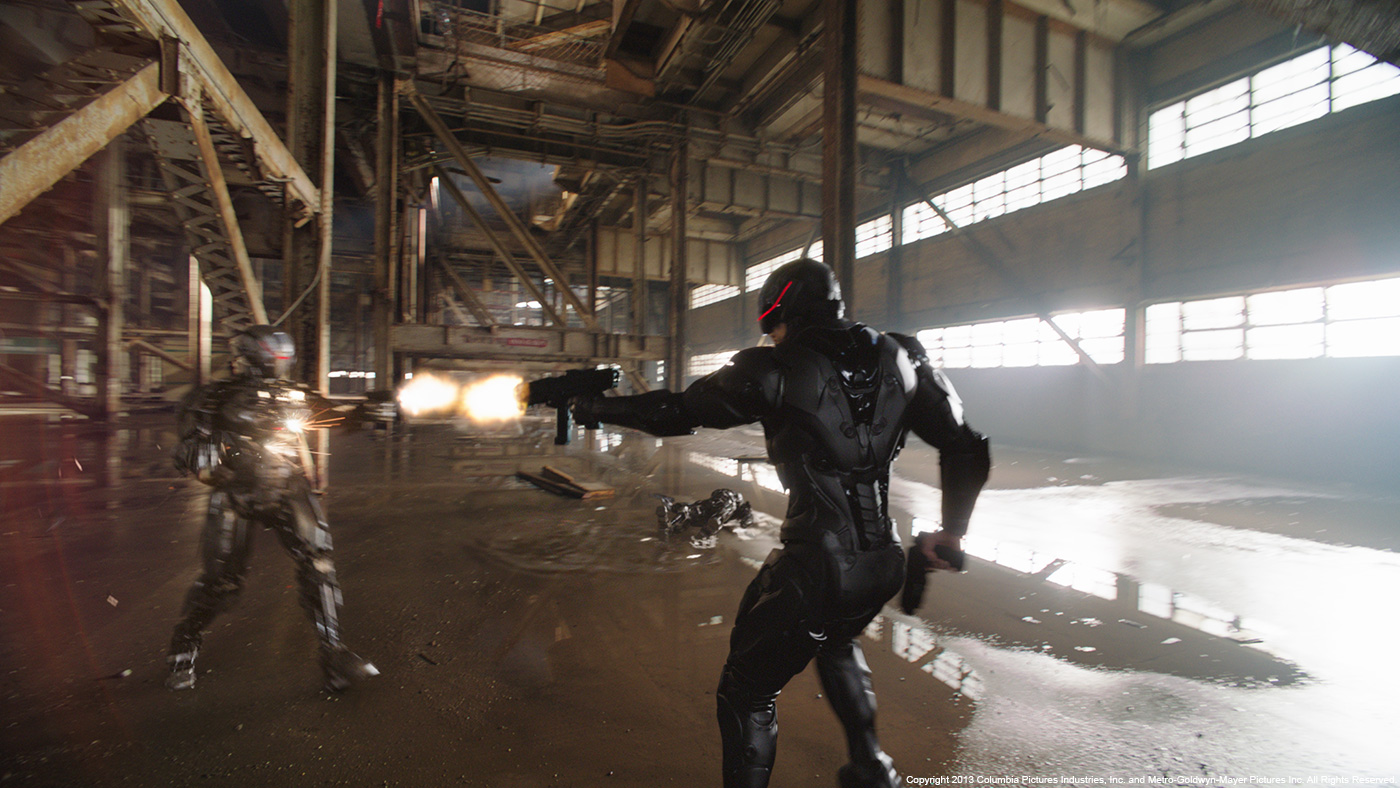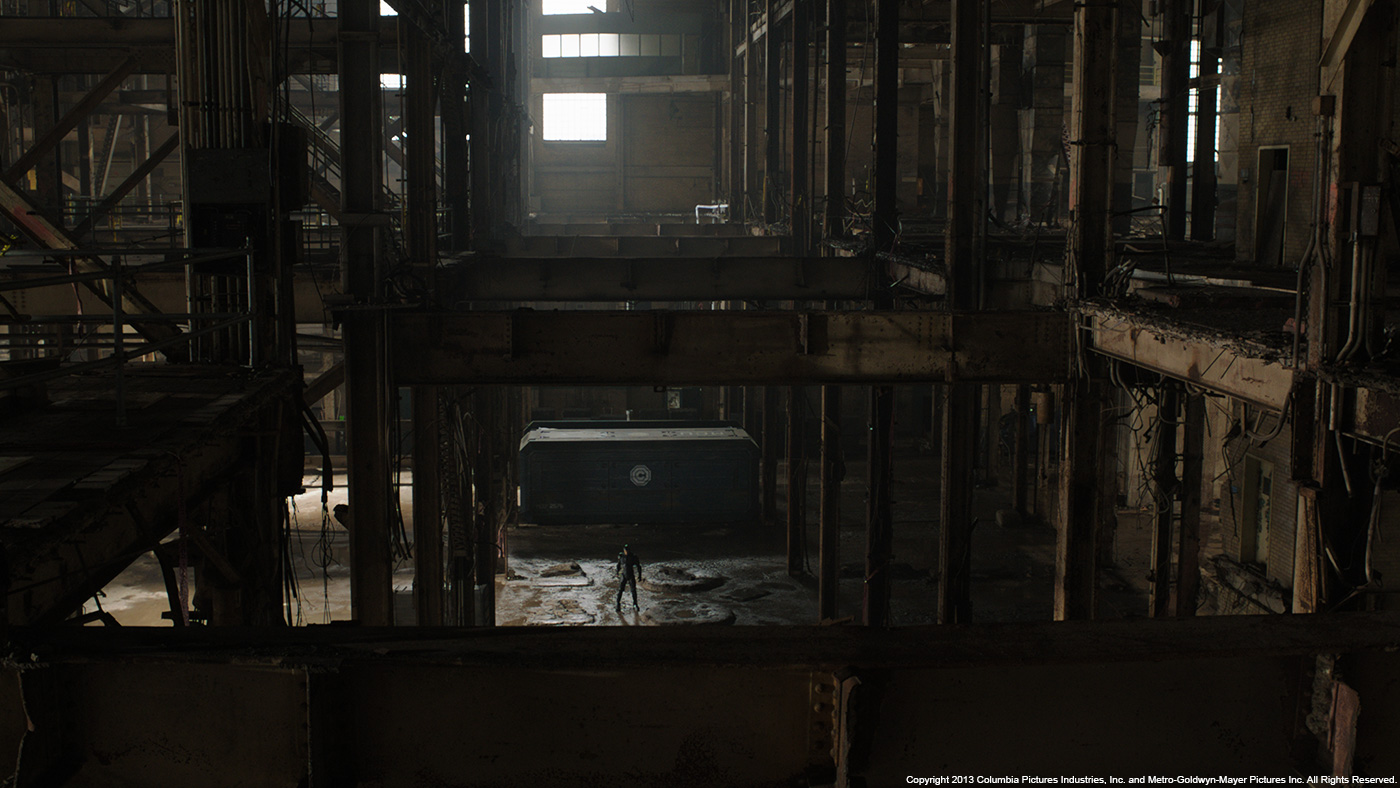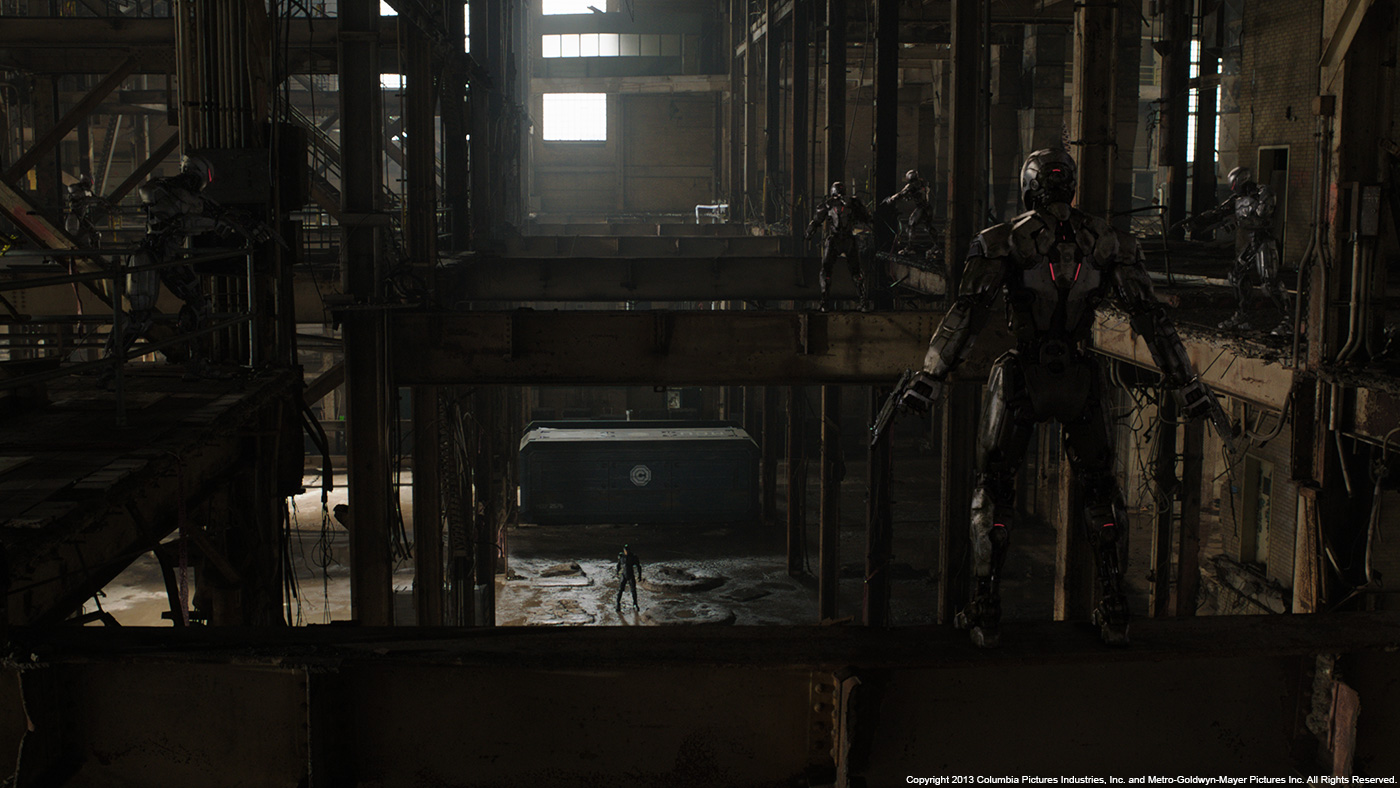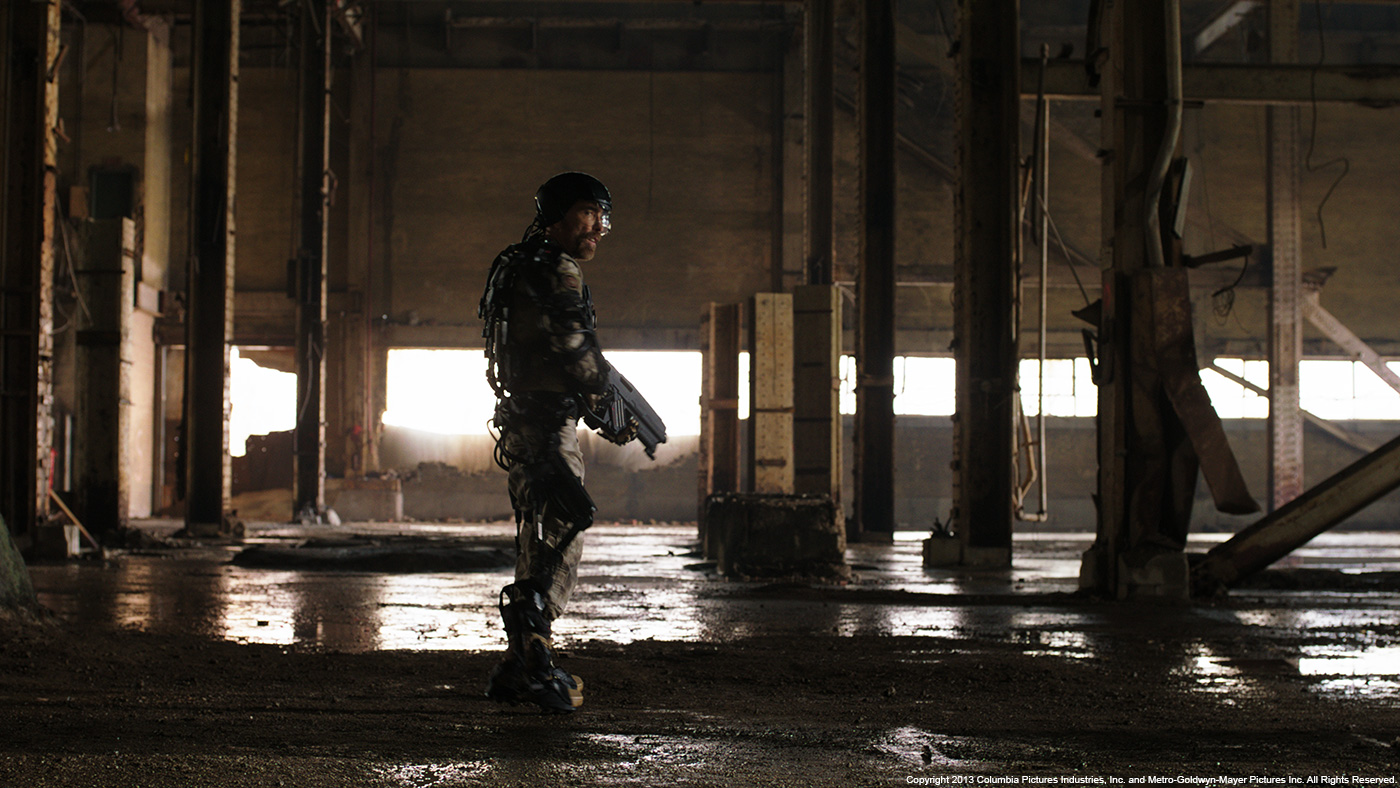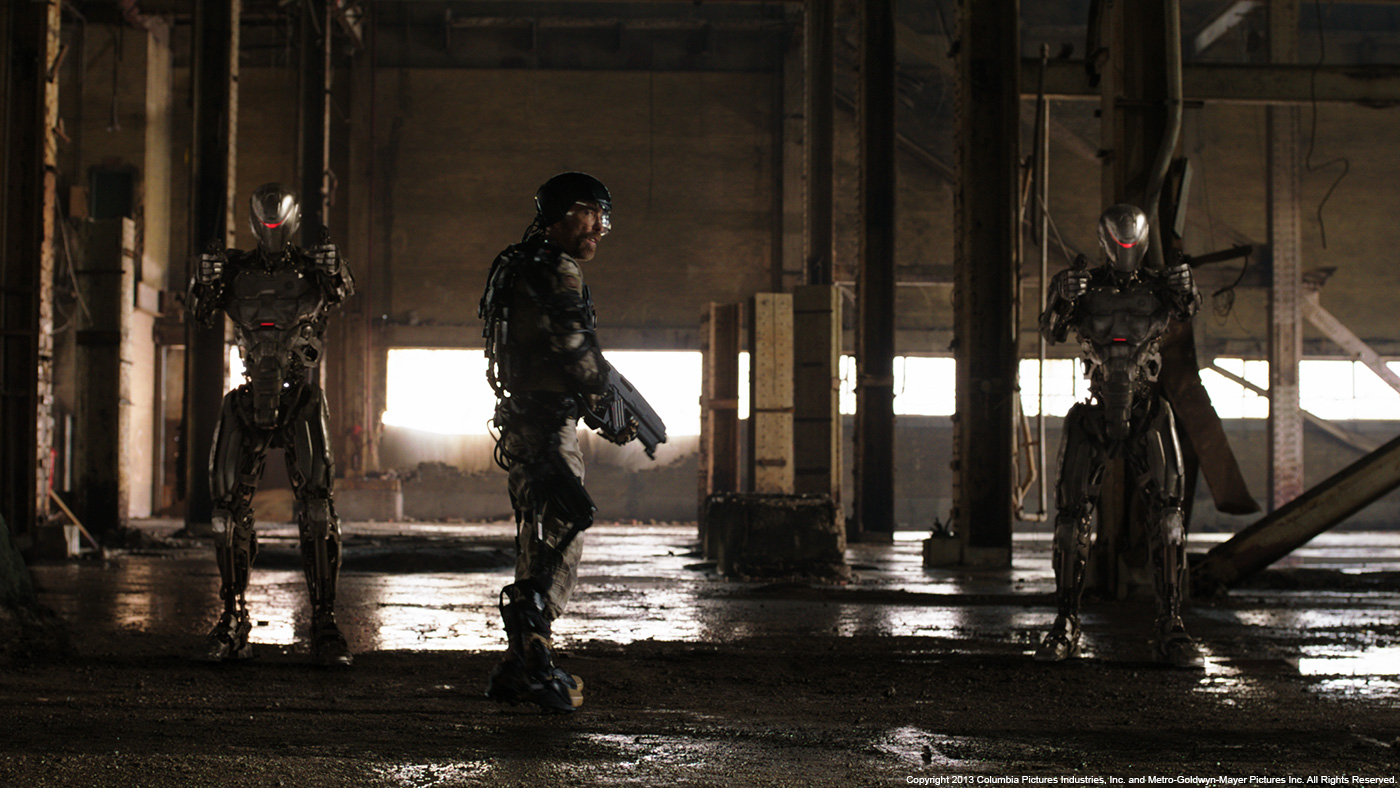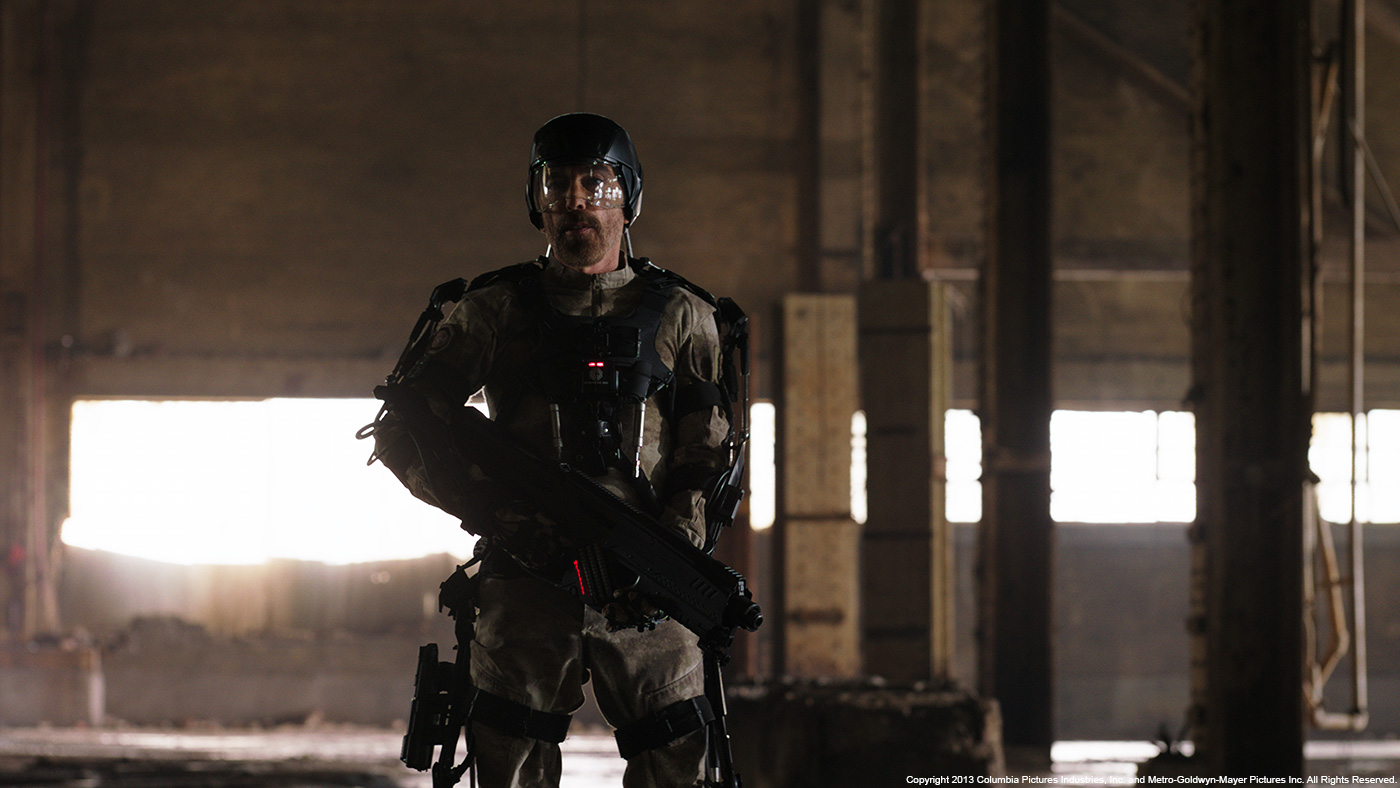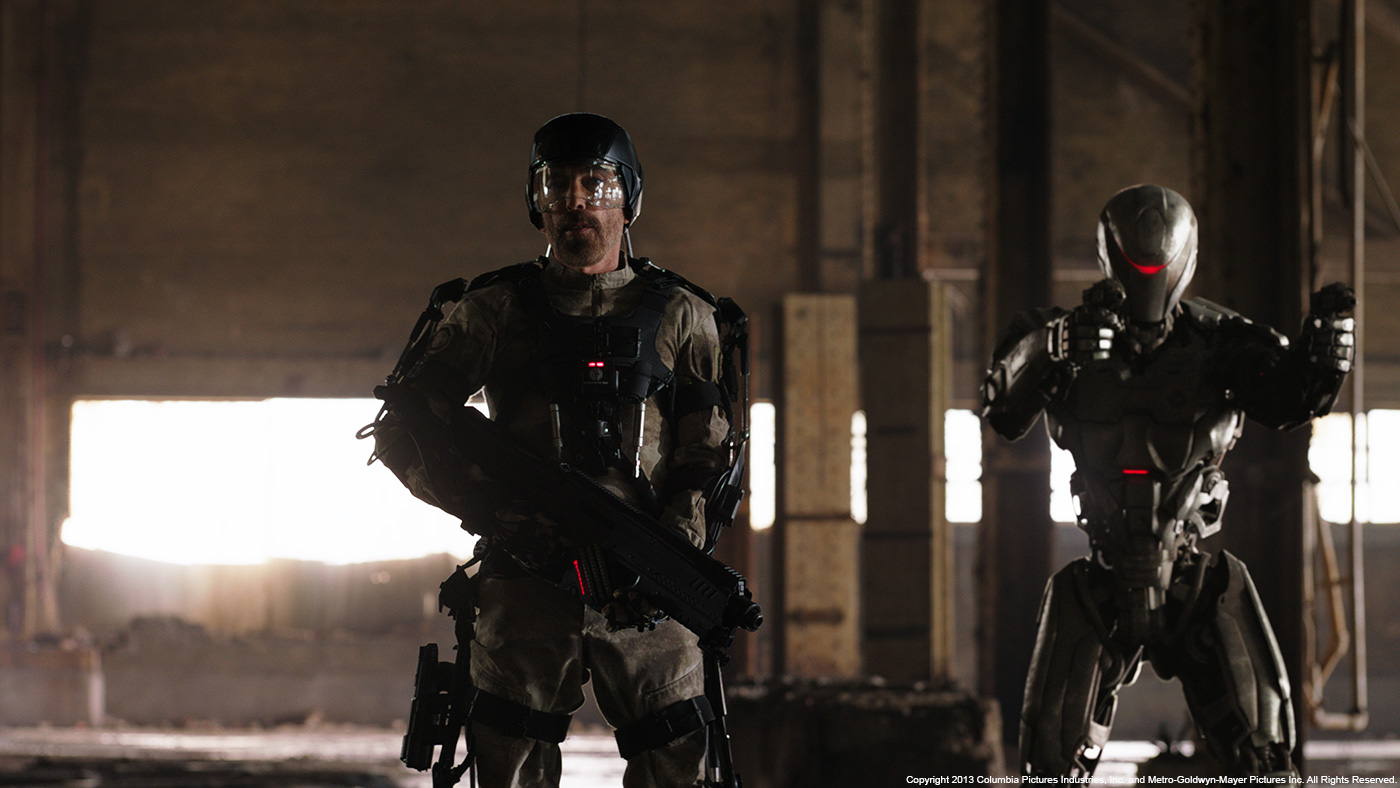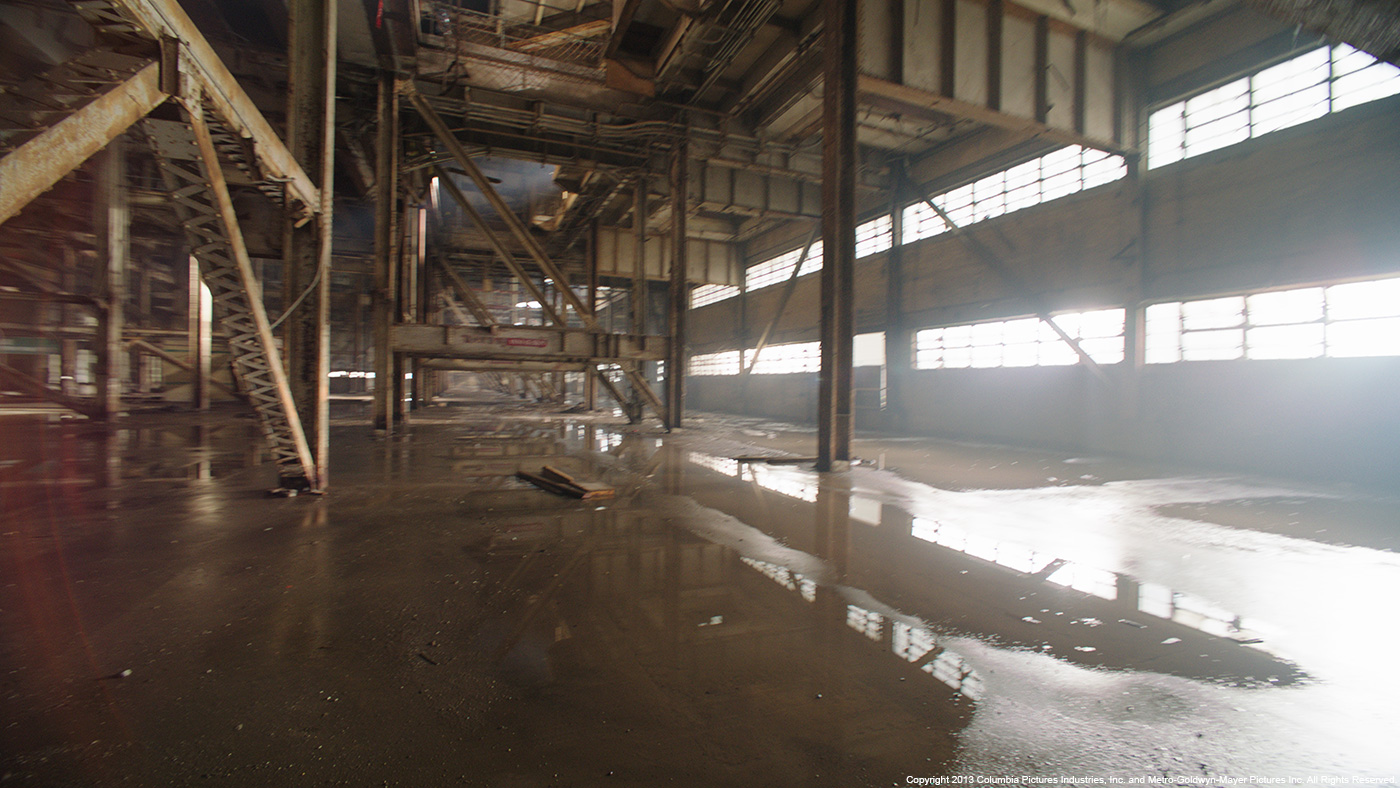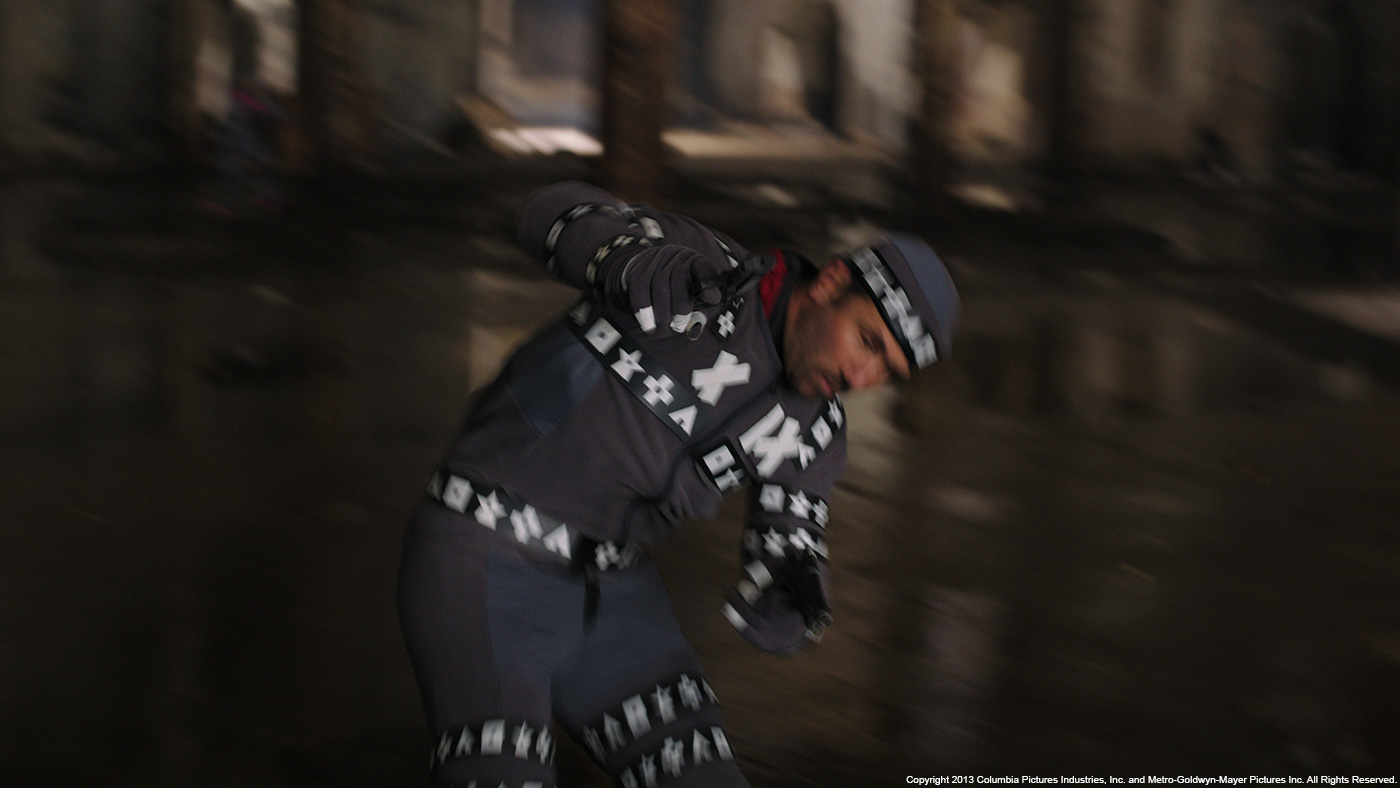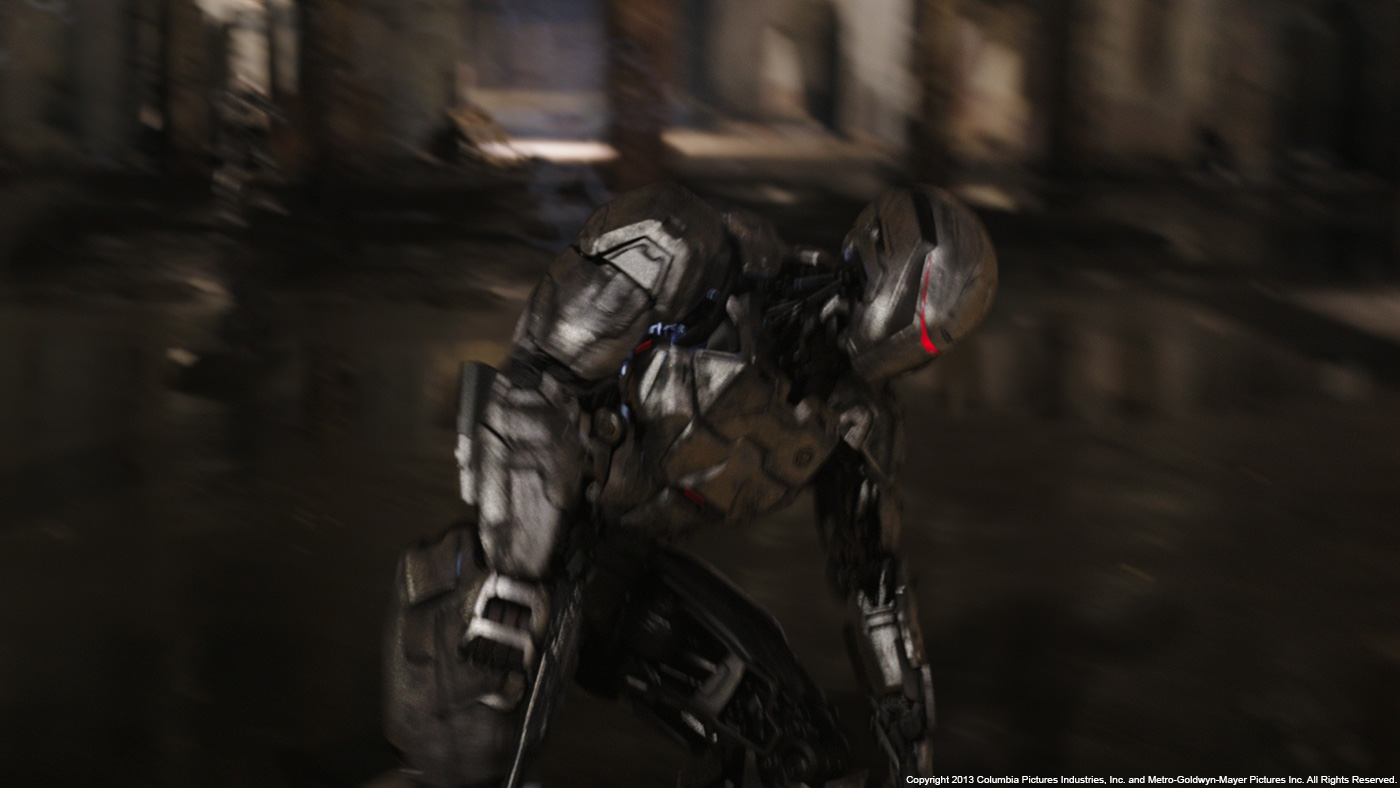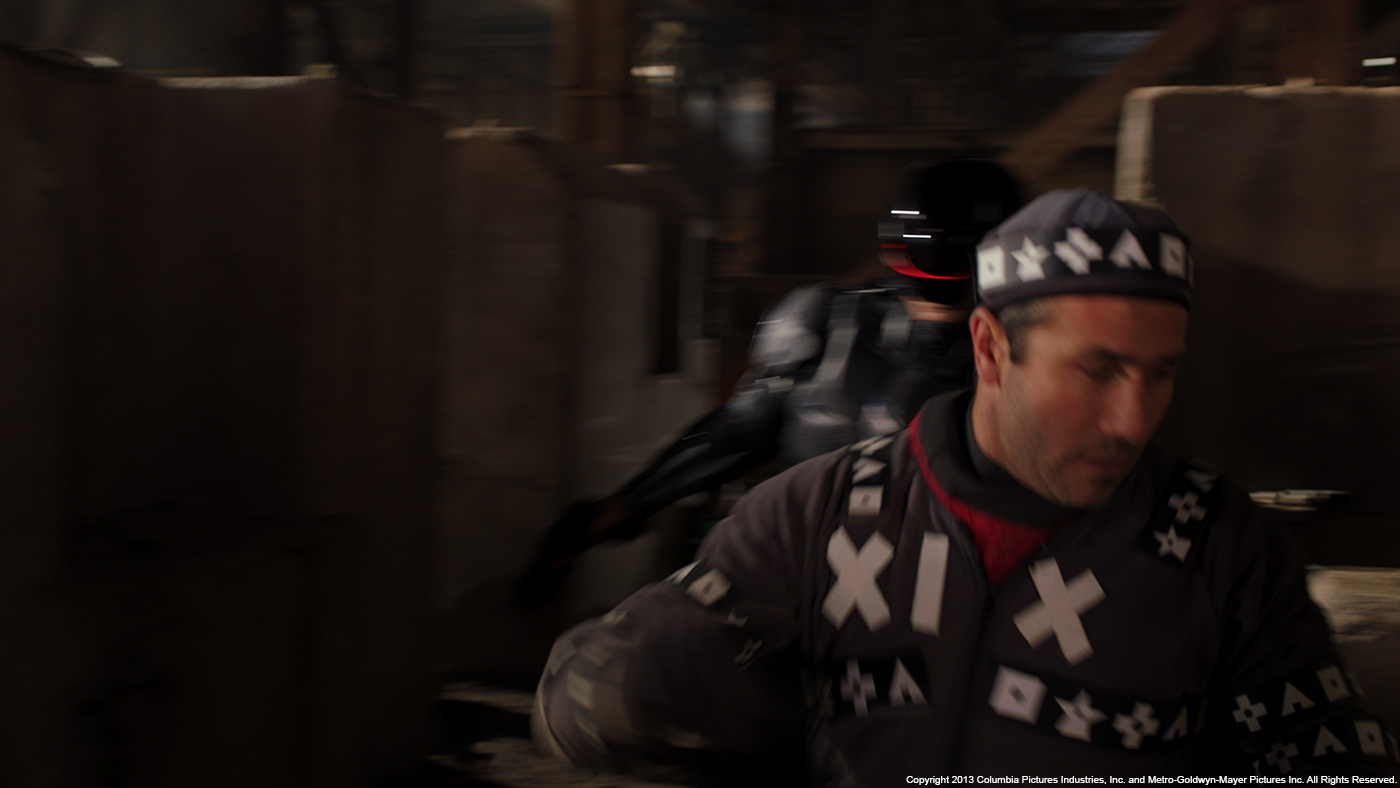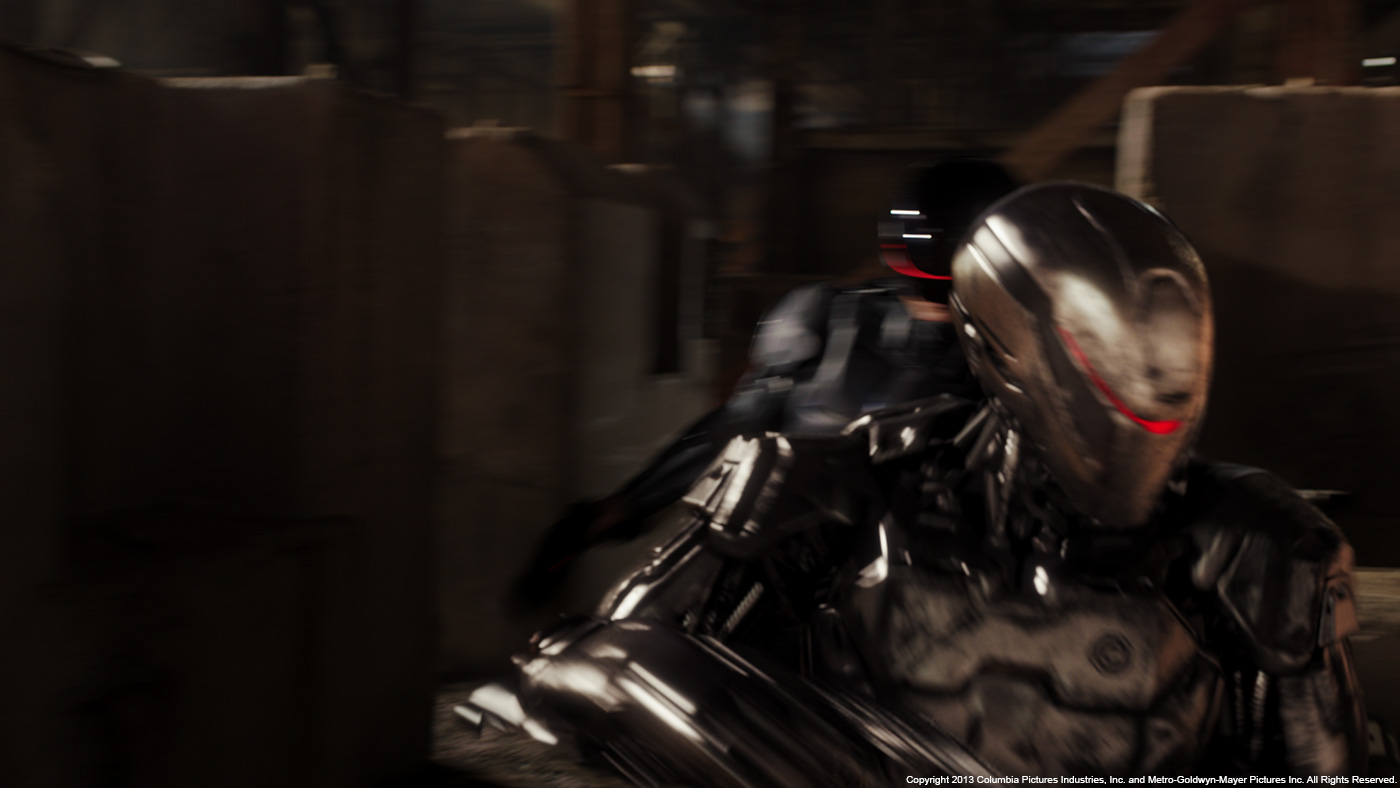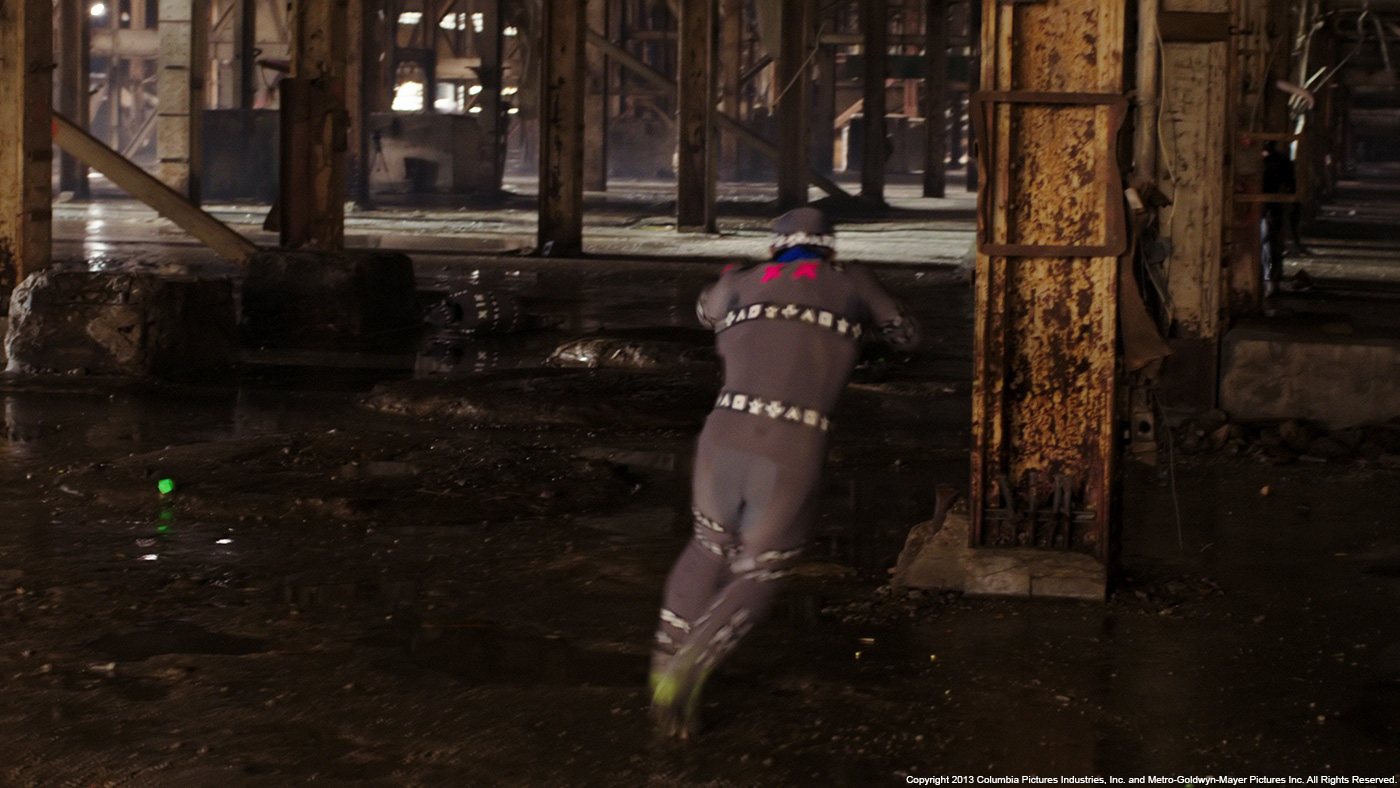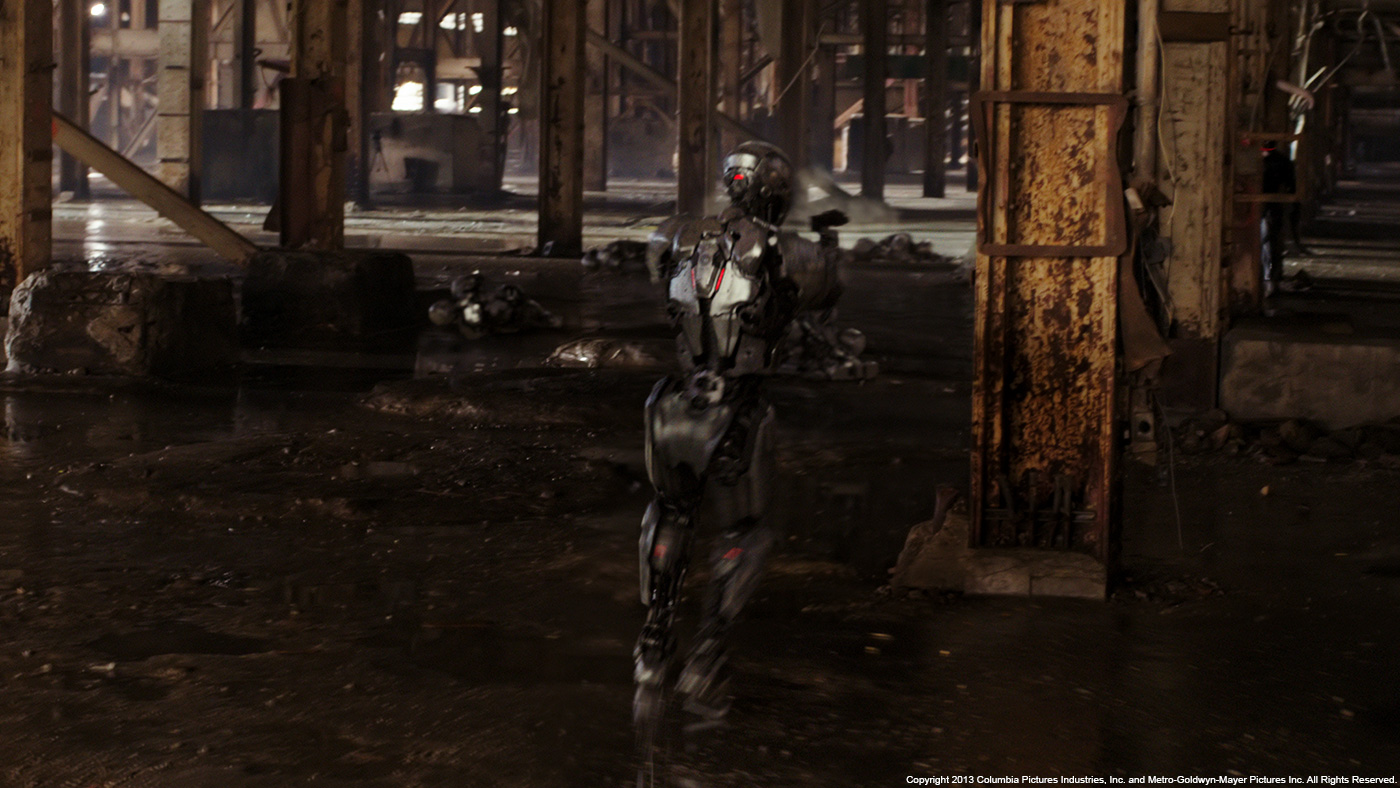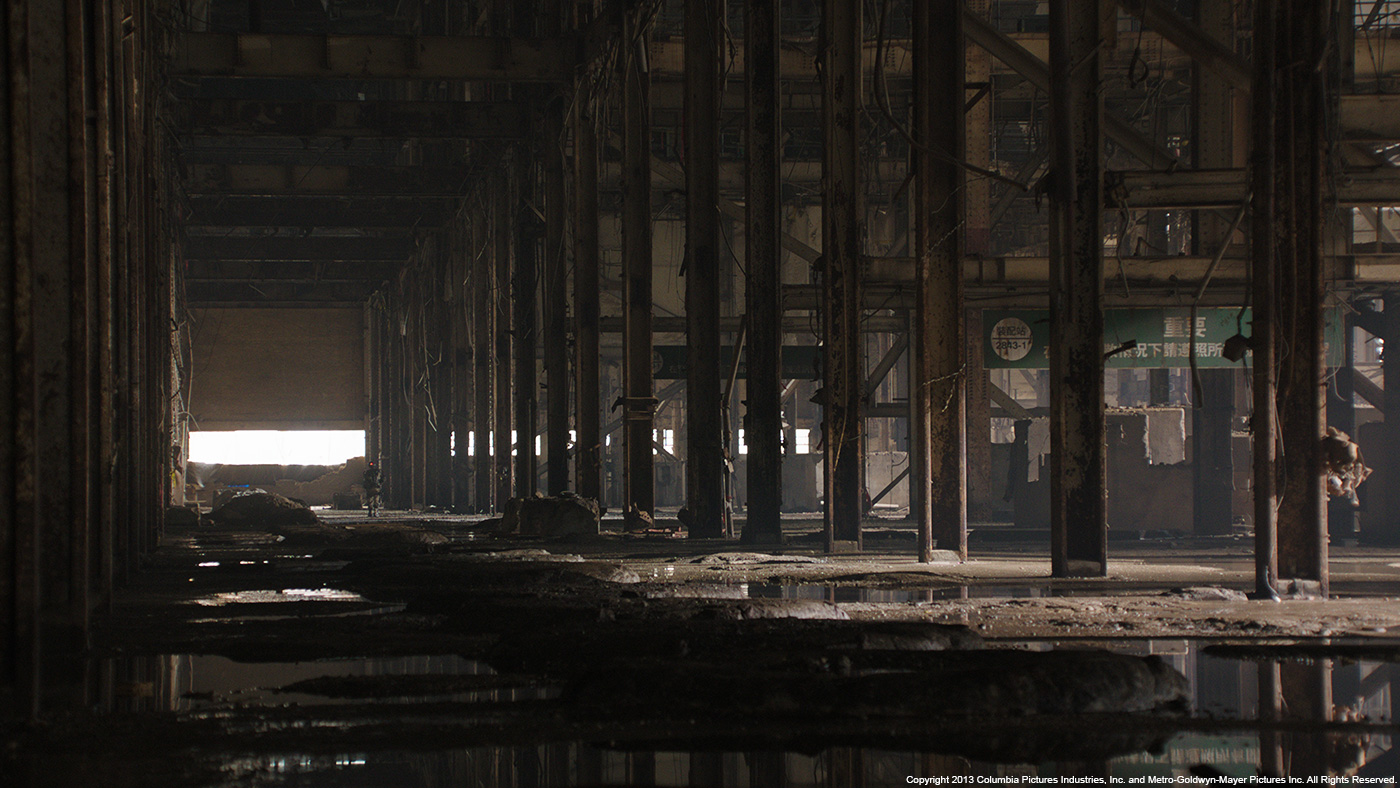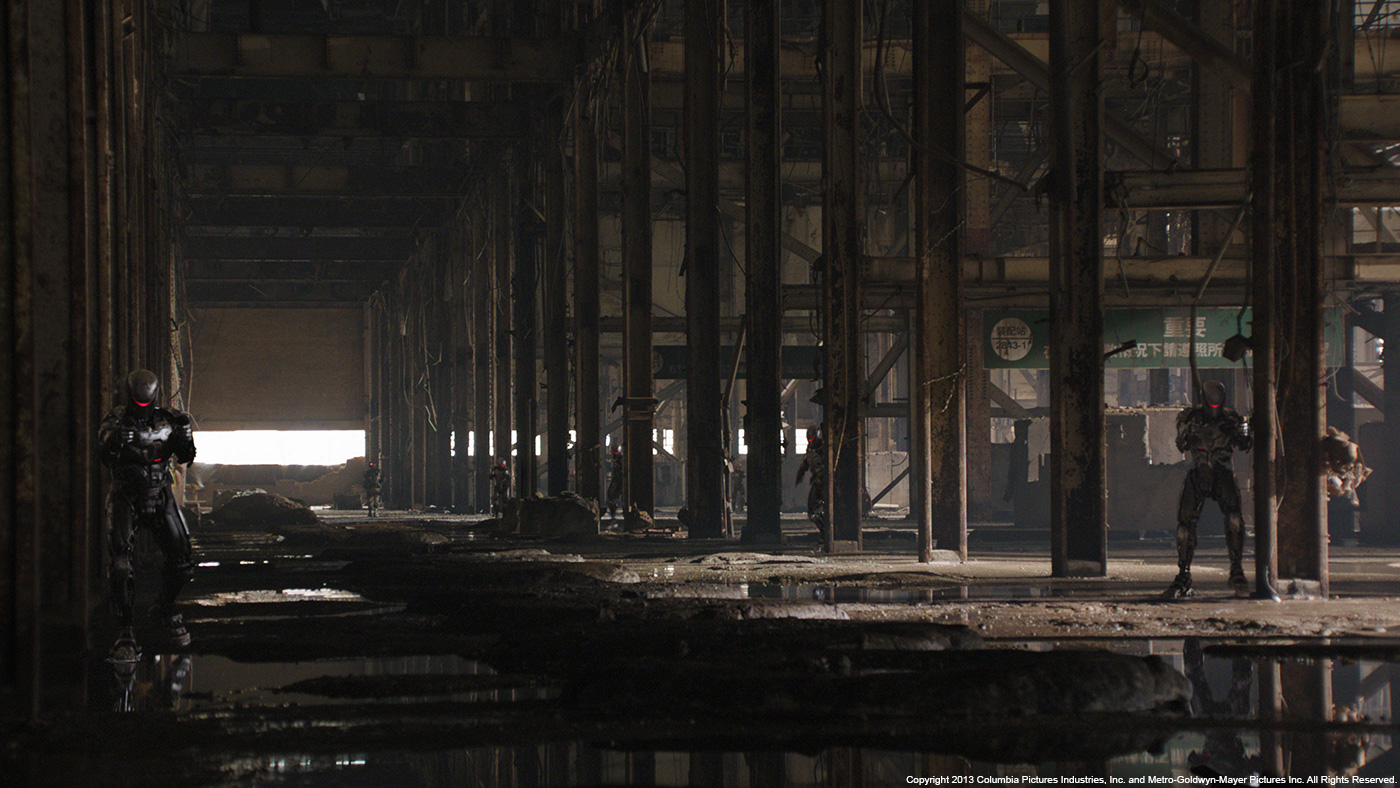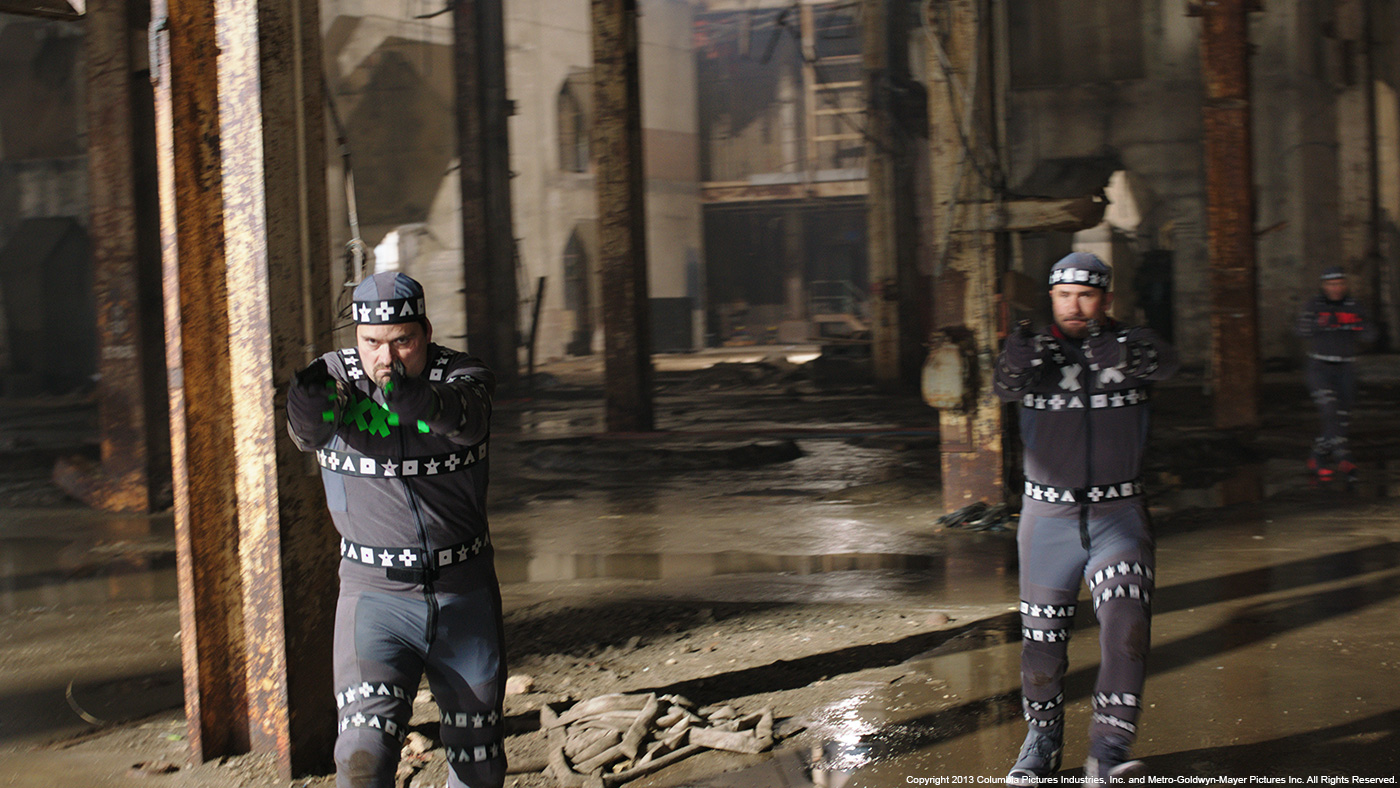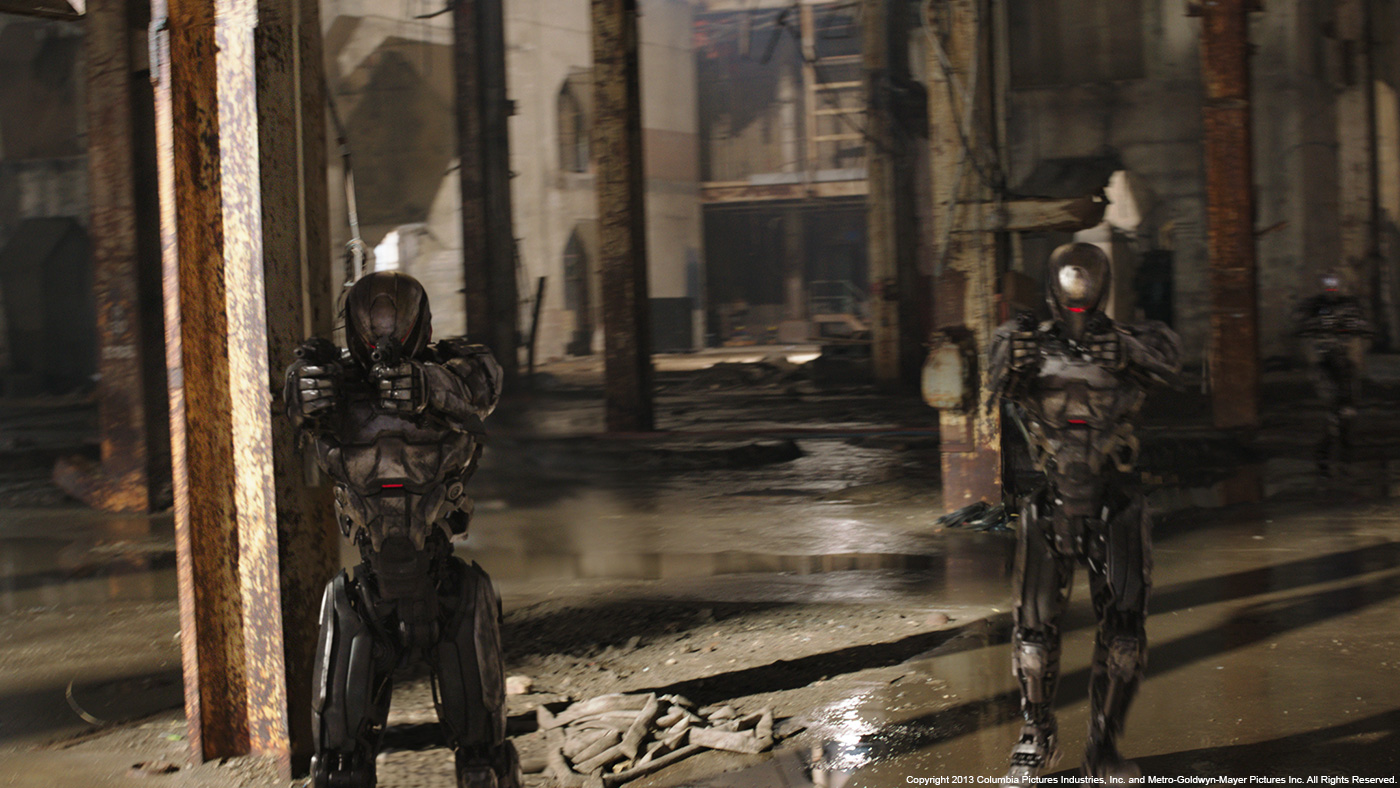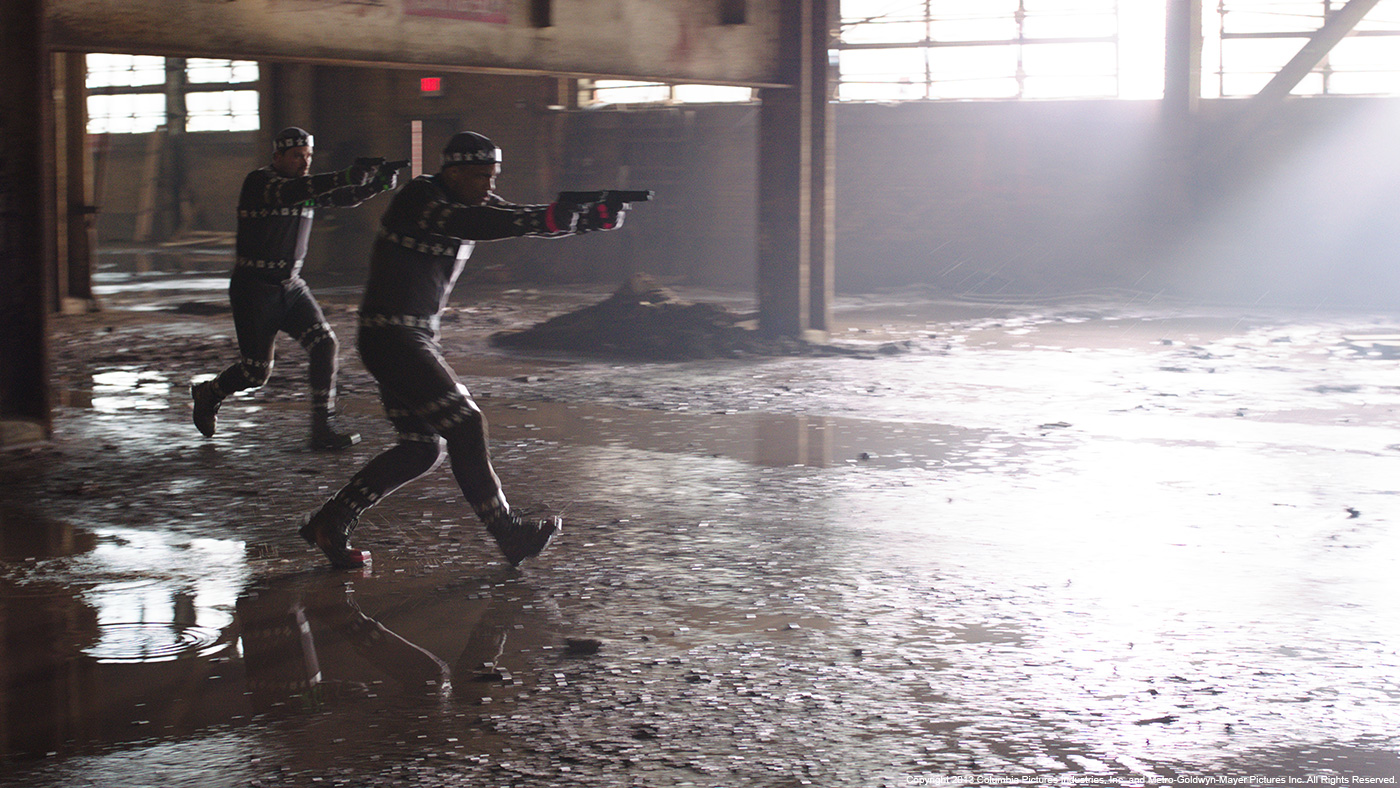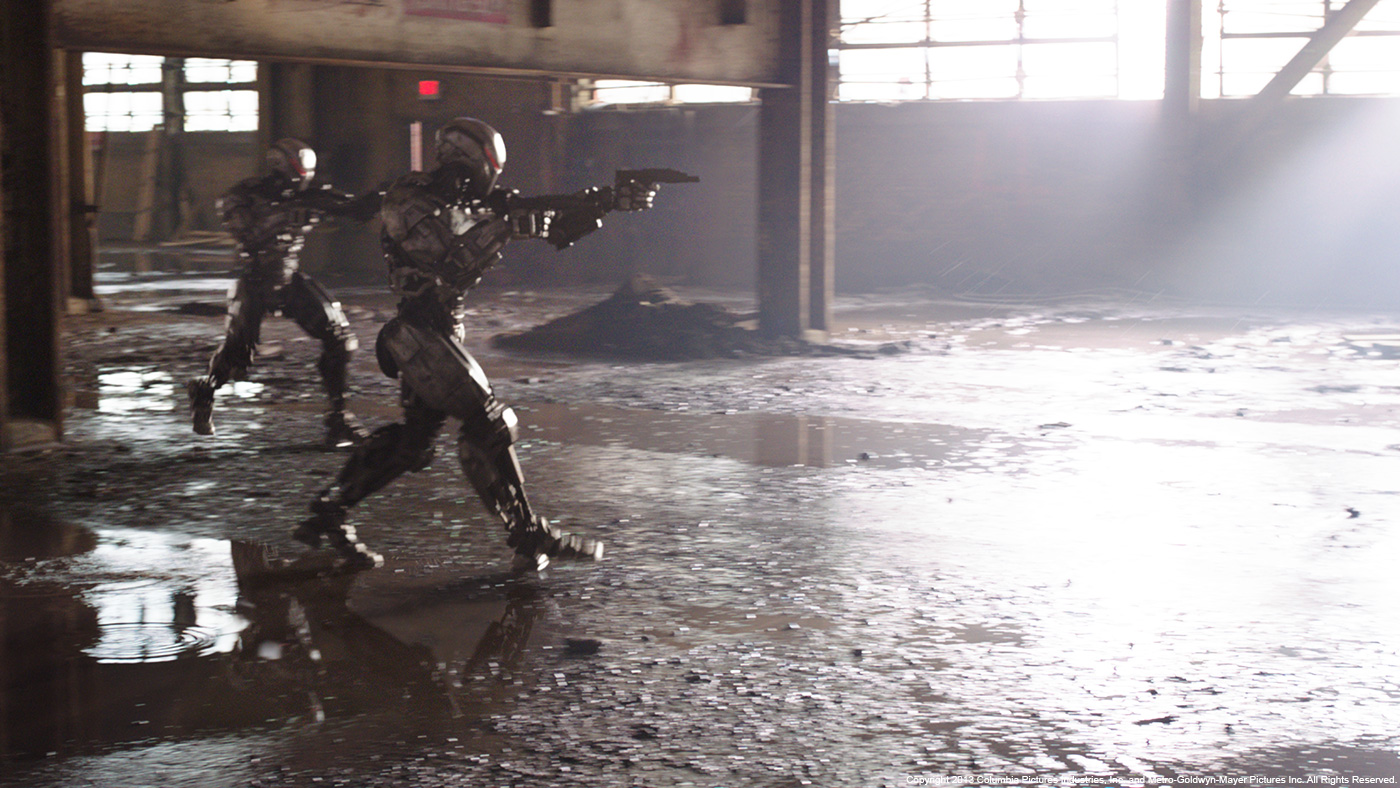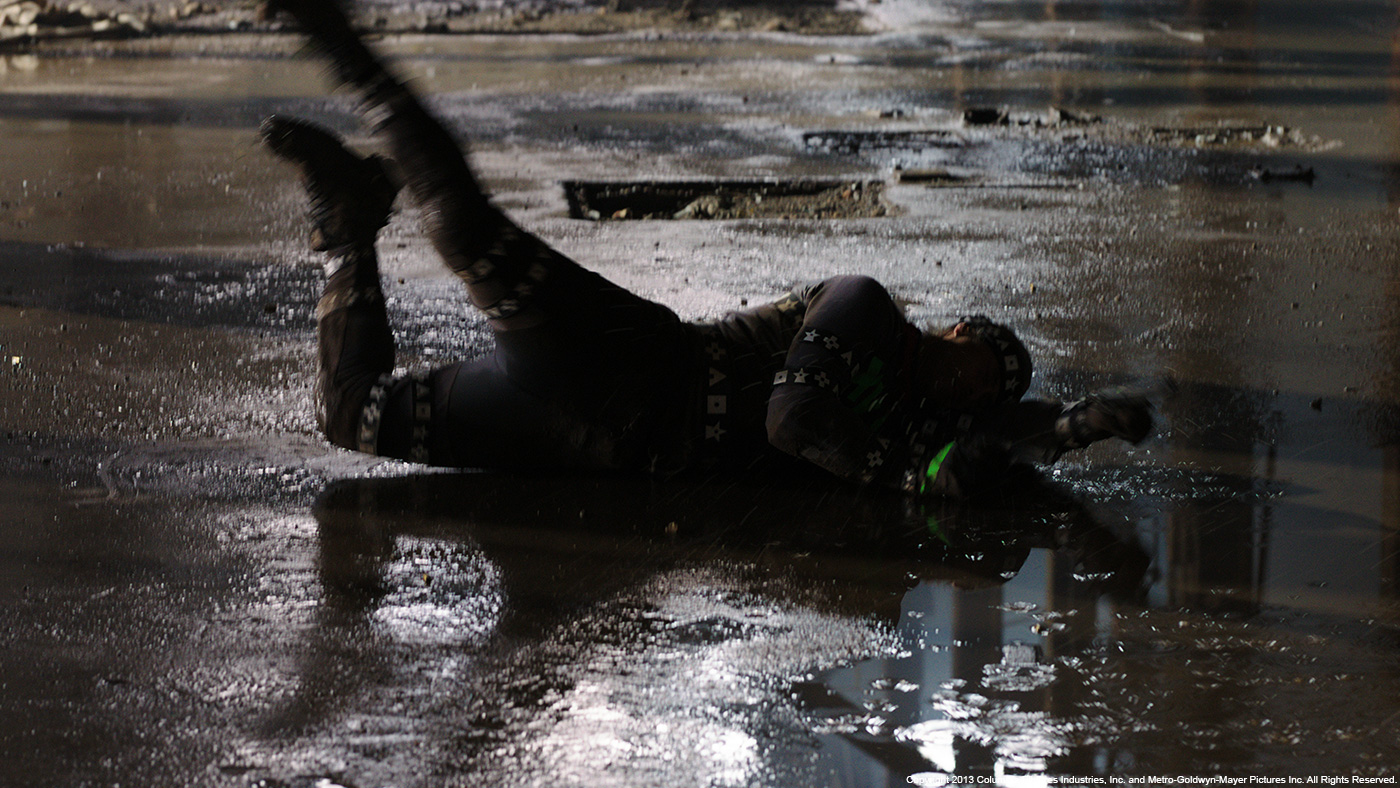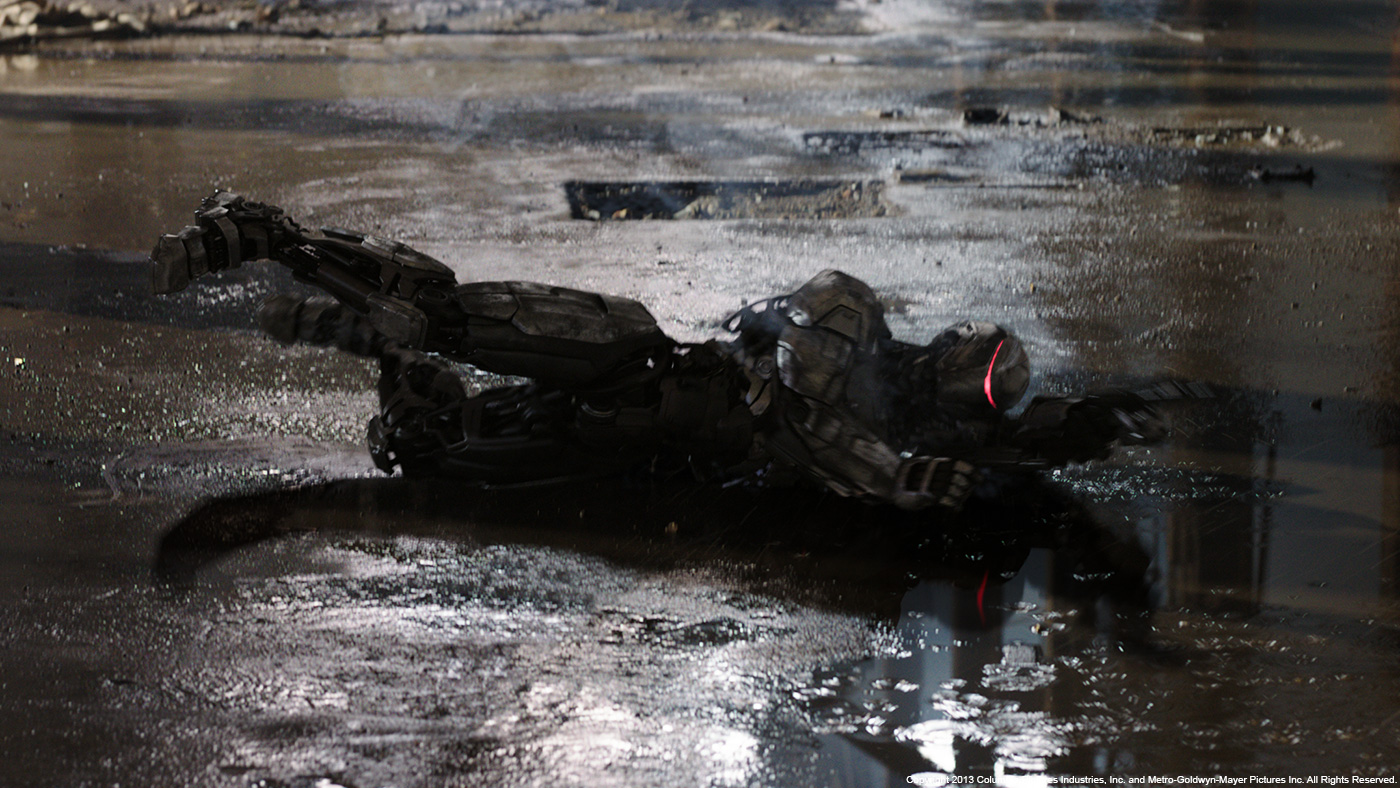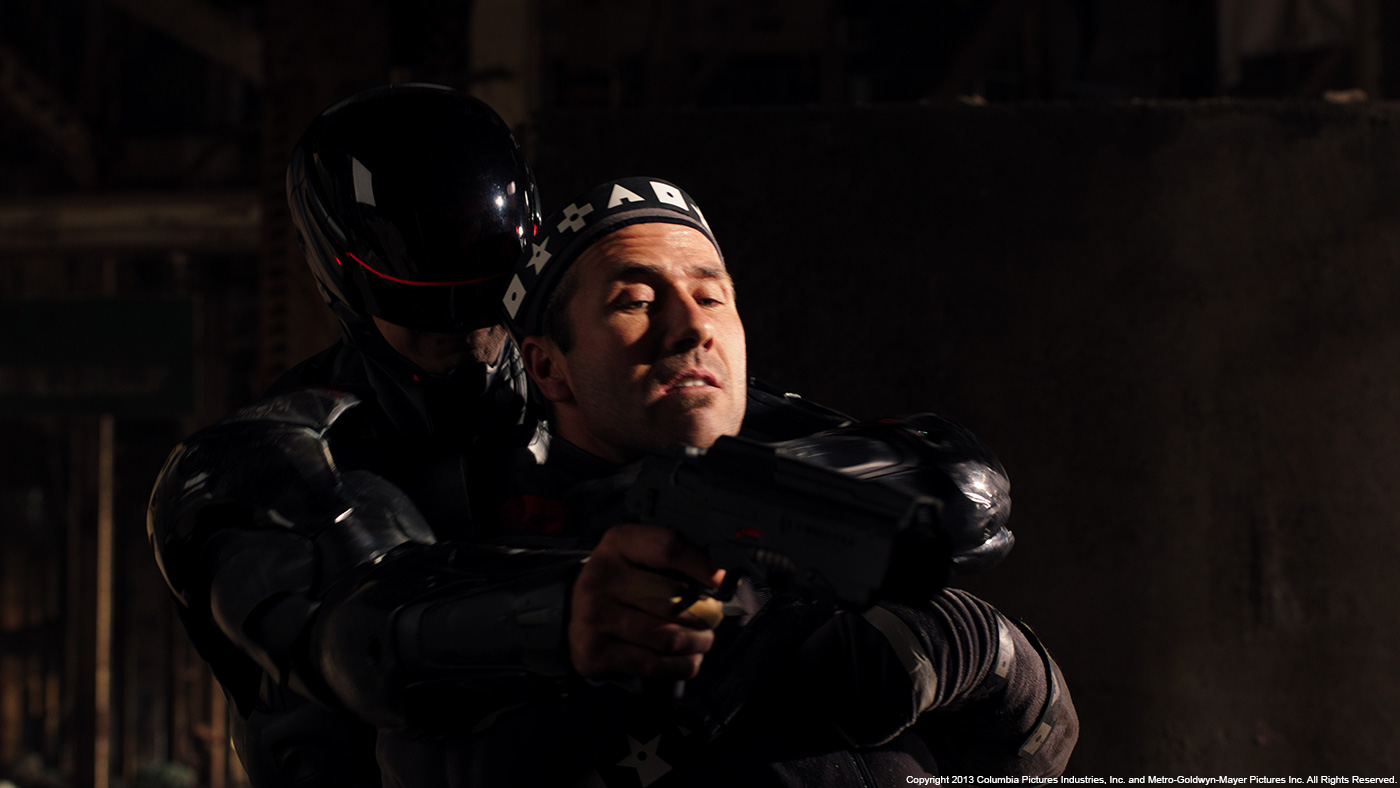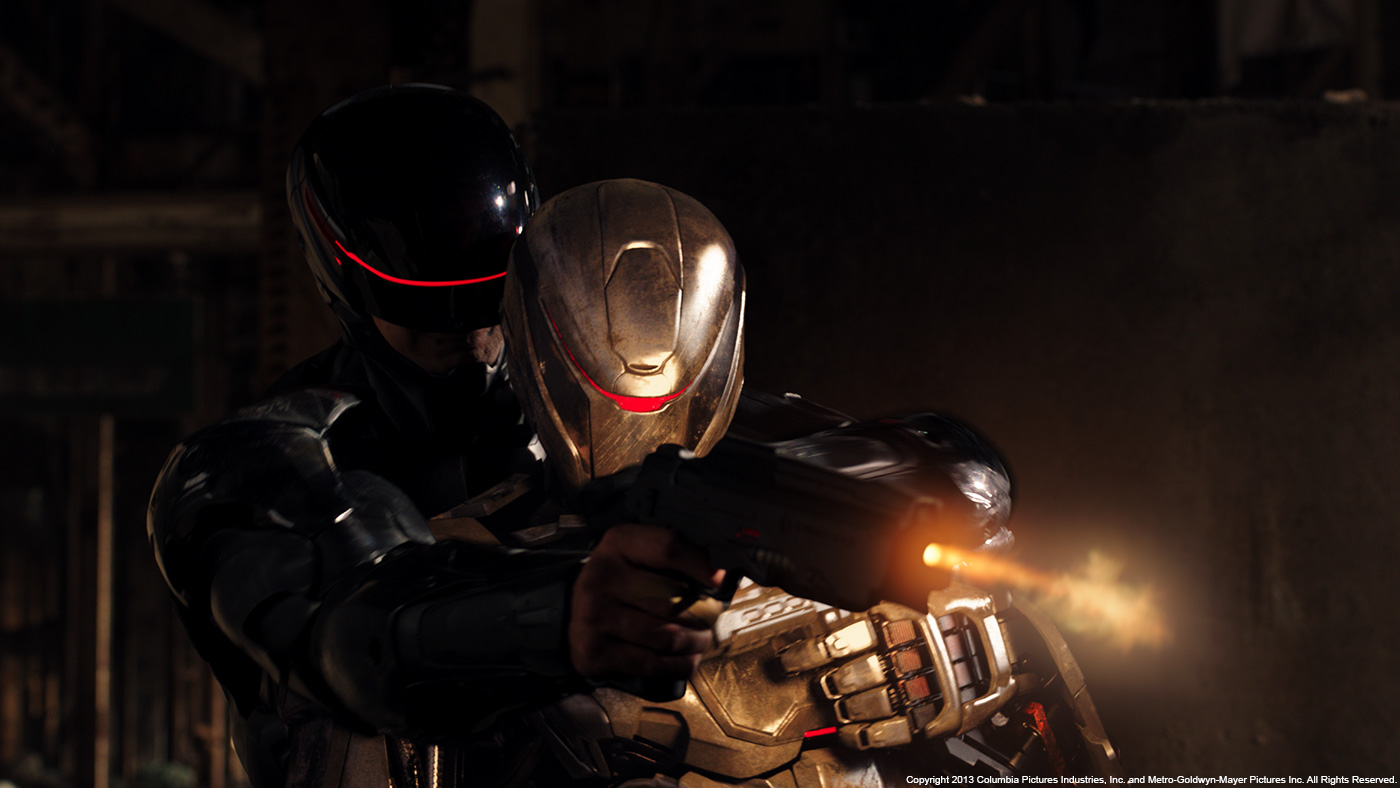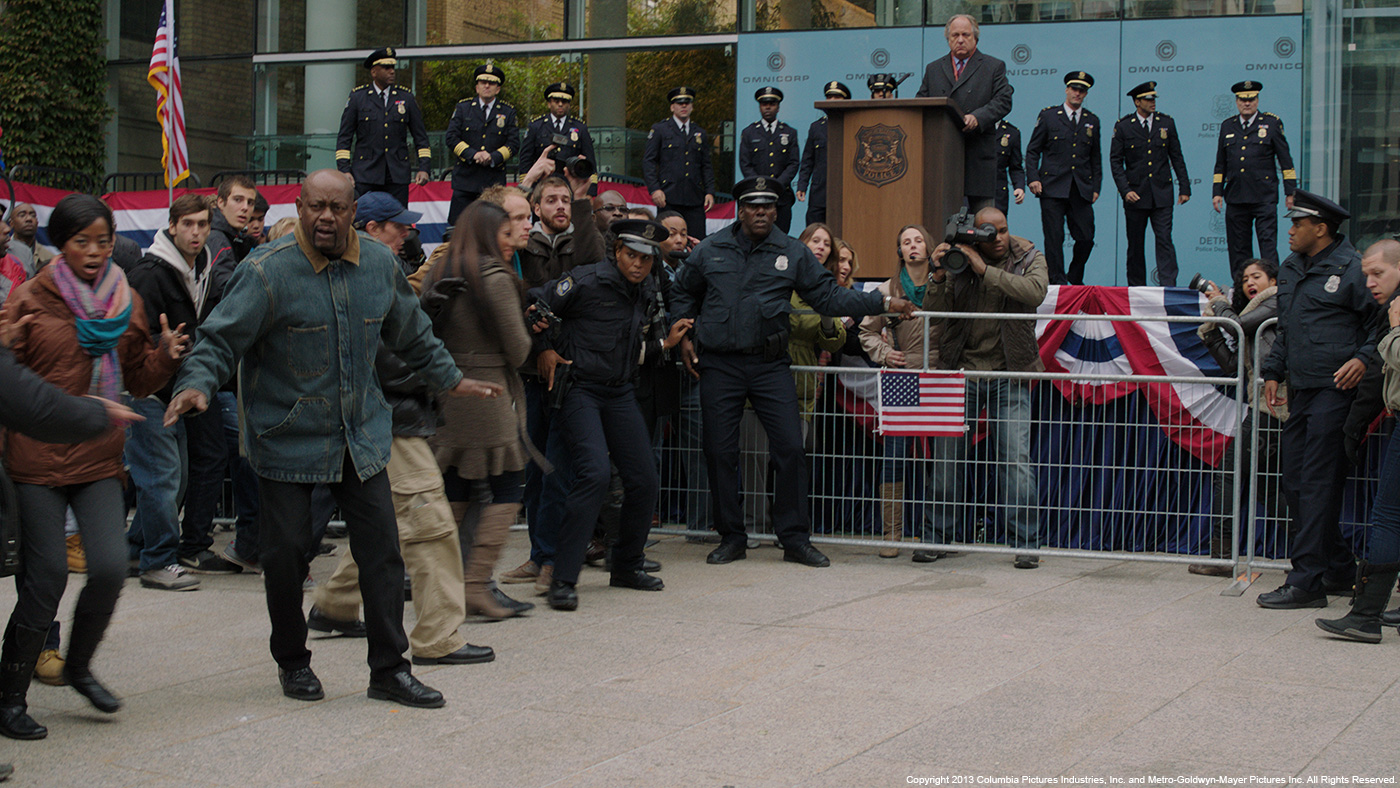Last year, Craig Calvert had told us about the previs work of Mr. X on PACIFIC RIM. He then worked on the TV series THE STRAIN. And now he explains his work on the remake of ROBOCOP.
How did Mr. X get involved on this show?
When we learned that MGM and Strike were in development on the film, and shooting in Toronto, we reached out to them. Coming from past collaborations on CARRIE, DAWN OF THE DEAD, and THE THING, we were excited about the project and began crafting a pitch-piece to showcase our quality and prove we could handle a photoreal all-cg Robocop. We were put in contact with Legacy Effects to get a brief on the new suit designs, and began building a digital version of the updated look. Our test was short, aggressive, and well received by the studio, producers, and the director. Ultimately that effort paid off and demonstrated the passion we had for the project and our excitement to be involved.
How was your collaboration with director José Padilha?
It was clear from the first day that José was not only a very energetic director, but also very intelligent. His requests were always grounded in reality, and his expectations were that any work we do be fantastic but plausible. When we were testing out the idea of a motorcycle jump for the finale, he was quoting physics equations and which variables would drop out when solving for distance traveled, etc, etc…. impressive.
The big take-away with José was how approachable and eager to make a great film he was. He was really a joy to work with for all those months.
How did you work with Production VFX Supervisor James E. Price?
Jamie has always been great to work with. We last worked with together doing previs for PACIFIC RIM, and continued into the role with this show. It was a natural fit, having worked so closely not that long ago. The refreshing thing about Jamie is how he brings a sense of pragmatism and clarity to the work, helping to keep focus on what’s important and move things forward.
What was your role on this project?
I acted as Previs Lead during the shoot, and as CG Supervisor for Mr. X on the pitch work to land the job, and on the film once sequences were awarded.
What are the sequences made by Mr. X?
Mr. X came on board in the early planning stages. Our first main task was a full workup of the Tehran intro, for which we produced multiple blocking animations and technical shooting diagrams. We helped design the pacing and camera work for the sequence, rolling with many iterations of set design and story beats.
We created previs and shooting guides for that opening, the extended finale battle, and a large amount of technical visualizations for multiple sequences throughout the film. Those included anything that required careful set planning or specific camera moves. Sequences like the backyard dream transition, China rice-paddy escape, or car explosion and crime scene investigation, were carefully planned at the previs level prior to shoot.
Later we were awarded several sequences in the film, including the fantastic Obstacle Course shootout.
What was the advantages to be part of the preproduction process?
Being involved with a show at the outset is a huge advantage. It gave us the ability to gel with the departments involved, help inform the decisions onset, and inject ourselves creatively at an early stage. That pays off tremendously because you can help stave off problems before they happen, and hopefully make the vfx work easier for all involved.
How did you created the previs?
A small team of artists worked out of the Production office at Pinewood Studios here in Toronto. We would meet daily with Jamie and with José when possible. Operating as jack-of-all-trades, we would jump from dedicated sequence previs to technical visualizations, or sometimes more exploratory work. Our maya-based toolset allowed us to quickly block in and revise shots, using the library of physically correct cranes and cameras we’d developed. We would work within boundary limitations of the soundstages at Pinewood or on location, and give quick turnarounds on shot blocking ideas. We also provided onset assistance if a new problem needed to be solved immediately.
What was your feeling to redesign the iconic Robocop?
The Art Dept. did a great job of crafting the new look for Robocop. Our mandate was to take their designs and create a production ready asset that matched the look of the practical onset suit. They provided us with a sample design model which we cleaned, re-proportioned, and textured and shaded to match the suit. We were proud to have that asset cut straight against the real thing, and not have the audience pick out the shots. Later we packaged and shared it out to other vendors.
How did you approach the creation for the new Robocop?
The Art Dept. model was a great foundation to work from, but there was a constant struggle between the idealized proportions of the hero asset, and the actual size and shape of Joel inside of the suits. We scanned several iterations of Joel and the stunt actors inside of each suit, and developed different assets that fit each exactly. In the end, we settled on a workable ideal shape that was a good blend between Joel and the two main stunt actors proportions, and the heroic form from the Art Dept. This allowed us to use the correct variant for tracking purposes when needed, and another for rendering.
Can you tell us more about the animation of the internal and weapons mechanism?
Inspiration for the holsters came straight from the iconic original, but was fitted to work with the sleek new stylings of the suits. We built several variations of the asset, to fit not only the two different weapon types, but also the different silver and black Robocop 1.0 and 3.0. Our lead modeler, Ray Ng, designed the framework and then it was on to getting the speed and mechanical nature of the animation finalized.
Can you tell us more about the rigging and the lighting?
For Robocop, Mr. X used a Maya/VRay pipeline. We lit almost entirely using onset hdr captures and some careful additional light placements. We set out with established sequence lighting templates, and were rendering rapid but good-looking lit sequences straight out of animation. That approach helped us get great looking temps into the edit as fast as possible, and leave no surprises with motion blur artifacts or general look come final render time.
All rigging was done in Maya, with the complex neck being a notable exception in its difficulty to execute. We circled around various means of articulating the multiple parts that slide against each other in such close proximity, and our lead Character TD, Charles Wardlaw, settled on a clever blend of driven-key motion with offset controllers to fix any issues after animation and before caching to Alembic. Both Robocop and the EM-208 were completed using our in-house modular autorig system.
Can you tell us more about the challenge of the various suit enhancements?
Even with an actor as fit as Joel Kinnaman is, there were times the Robocop suit didn’t have the heroic proportions that José was looking for. The suit needed to occupy the same physical space as Joel’s slim waist, but since prosthetics and costumes add volume by their nature, we always had to slim it back down to the original size. To do so, we would do a bit of a digital ‘tummy-tuck’ to narrow the waist and help get that V look.
There were other parts of the suit that sometimes didn’t read as mechanical enough. The shoulder internals were a rubber undersuit that Joel was wearing, and we often replaced these with gears and pockets of negative space, to further make him look robotic. The neck was similarly replaced in many shots, swapping bending rubber for sliding pistons and interleaved panels. Our Robocop 1.0 shots called for a stomach replacement. That area was designed for multiple pistons and articulated levers that the practical suit simply couldn’t do. Where needed we replaced it with rigged cg version and lit to match.
In a sequence Robocop is confronted to numerous EM-208s. Can you tell us more about your work on the EM-208s?
The Obstacle Course sequence was great fun to work on. In it, Robocop is confronted with a series of EM-208 droids that he has to blast his way through, while dodging their fire. Where Mr. X took the lead on creating and sharing the Robocop 3.0 asset, we absorbed the EM-208 from Framestore and pushed it into our structure, rigging to our standards and building shading networks to match their look.
A great deal of exploration went into the motion style of the 208s. Stunt actors dressed in grey suits with tracking markers formed the foundation for shot blocking and character movement. We were initially given the mandate to have a perfect mocap of the stunt performance, and went down a path developing onset capture using calibrated reference cameras. Even with that system running, it was quickly clear that the performances between actors varied too greatly to give the feel of industrial robots. There was too much humanity and not enough limited, technical motion in their actions. We shifted away from the idea of true mocap, and instead used it as a starting point for our keyframe animated performances based off of their main beats.
The shooting location for the Obstacle Course was the decommissioned Hearn electrical station, a vast space of rusting girders and piping. We LiDARed the space, and built a reference set for previs and later for lighting. We were able to map the lighting conditions throughout, shooting hdrs at most intersections points along the grid-like layout. This gave us a wealth of location-specific lighting data, and let us accurately recreate the look for each shot. Coupled with our accurate model, we could position a 208 and know what the lights were at that exact point, and which of the hundreds of girders would be casting shadows in what direction.
During the assault, Robocop used his two guns to disable the 208s; a machine pistol, and a Taser. We developed two different looks and animation styles depending on how each was hit. For the bullet strike we custom-built exploded geo and mechanical internals, so we could showcase the violence. When the Taser was used, we used an internal array of lights and sparks, and set the 208 into a spastic pattern as it collapsed in a heap on the floor. There was a great shot where Robocop blasts several 208s at close range (one in the face!) while maneuvering behind a girder for cover. That was a fantastic piece to work on, and showcased not only our 208s, but our fully digital Robocop filling the frame and cutting directly against the actor in the next shot.
Have you collaborates with the other VFX studios?
This show was definitely a team effort, and it was great to be paired with Framestore and the many other vendors involved. We would have weekly calls to discuss common issue we faced, offer solutions to each other, and work to ensure look-continuity across all of our shots. It was a very positive experience.
Mr. X took the lead in developing the Robocop 3.0 asset and weapons, which we shared out to all involved. In turn, we absorbed the Robocop 1.0 and EM-208 model and fit them into our pipeline.
How did you created the CG visor?
There were many shots where the Robocop 1.0 or 3.0 visor needed to be added. Sometimes Joel would be shot without the visor attached, or the visor that was present had a visible issue needing fixes. Notably with the red glowing line during the Obstacle Course, the internal light mechanism had to be removed as it was blocking Joel’s ability to see. We would later add that back on throughout.
There were several hidden technical issues with the suit, and the visor in particular, that we worked to conceal. We found that with suits as complicated as Joel was wearing, there were times when parts had shifted, or were misaligned, and no longer fit the standard model you had built for. We would often do shot specific adjustments, warps, or model changes to keep all visors feeling the same, even if they technically weren’t. In the end, the audience couldn’t spot the various tweaks we made, and they came off looking great.
Robocop is revealed to the public in a sequence. Can you explain in details about your work on it?
The majority of the work in that sequence dealt with suit fixes. The neck and shoulders were replaced throughout many shots with the cg mechanical versions. We used 2d slimming techniques for the abdomen where possible, keeping the plate intact and warping and painting back where needed.
During that sequence, Robocop spots a wanted criminal in the crowd and leaps off the stage to apprehend him. A practical jump was shot, but it wasn’t dynamic enough for José, and we were tasked with a digital solution. We used our cg Robocop 3.0 asset and animated him clearing a much greater distance, drawing his gun, and advancing into the crowd.
The crowd of extras in the square needed to be expanded to give the right feeling to the scene, of an excited crowd awaiting Robocop’s debut. We worked to duplicate and fill in any empty pockets throughout the shots, drawing from additional elements or the original plate to give a larger turnout to the event.
How long have you worked on this film?
From the initial pitch to final delivery, Mr. X was involved for over 1.5 years.
How many shots have you done?
We completed approximately 200 shots for the final film with a team of 82 artists, supervisors and production support.
What is your next project?
Mr. X is currently in development on CRIMSON PEAK, GET ON UP, THE STRAIN, PENNY DREADFUL, VIKINGS SEASON 2, and THE HUNDRED-FOOT JOURNEY.
A big thanks for your time.
// WANT TO KNOW MORE?
– Mr. X: Official website of Mr.X.
© Vincent Frei – The Art of VFX – 2014


